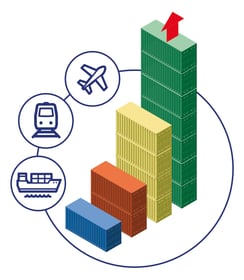Can Transport Logistics Reduce Risk?
Nick Ostdick - November 07, 2017

 It simply cannot be stated enough or more clearly: Success for manufacturing companies stems largely from the ability to control, mitigate, and reduce risk. While success can mean a number of things to any number of companies, the capacity to reduce the amount of uncertainty in operating a global supply stream is perhaps one of the most critical pain points across today’s manufacturing landscape. No matter how hard planners and managers work to contain risk, the sheer nature of a variant-rich supply network means risk in a variety of forms can plague companies across the entire value chain, everything from planning and procurement to production and transport logistics.
It simply cannot be stated enough or more clearly: Success for manufacturing companies stems largely from the ability to control, mitigate, and reduce risk. While success can mean a number of things to any number of companies, the capacity to reduce the amount of uncertainty in operating a global supply stream is perhaps one of the most critical pain points across today’s manufacturing landscape. No matter how hard planners and managers work to contain risk, the sheer nature of a variant-rich supply network means risk in a variety of forms can plague companies across the entire value chain, everything from planning and procurement to production and transport logistics.
All this being said, there are a number of strategies, solutions, and principles manufacturing companies can deploy and integrate to reduce the level of risk in a cross-organizational manner that also helps to increase productivity and enhance efficiencies. One of the more integral tools in a manufacturing company’s toolchest is transport logistics. Or, put simply: the coordination of efforts, resources, and personnel to successfully moving products from the production floor to the customer’s front door. It sounds quite basic, yet in an era of varied partner networks and variant-rich production programs, it can actually be a significant challenge for manufacturing companies across an array of industries. But for companies that deploy a successful transport logistics strategy, there are a great many benefits to be experienced beyond simply delivering products during pre-defined delivery windows.
While this is all well and good, the question becomes: How can a transport logistics strategy actually cut the complexity of complicated partner networks and reduce the risks involved with leveraging a worldwide supply stream? What elements of transport logistics provide manufacturing companies with real value in increasing the efficiency of their planning, production, and transportation platforms? With these two important questions in mind, let’s examine a handful of ways transport logistics can help manufacturing companies reduce risk in an increasingly connected production landscape.
Controlling operational costs
Transport logistics are not a fixed element of global supply chain management. Because of the variables involved (fuel costs, routing detours or delays, variances in weight, and other aspects), there are inherent risks with moving finished products across a varied partner network with the end result being the customer. Because a transport logistics solution gives planners and managers the power to call and review data related to fuel consumption and prices, reliability of transport routes, full load versus less than full load, and even factors such as weather or route disruption, companies can in real-time make adjustments to transport planning to avoid such complications or disruption. However, this foresight can also provide manufacturing companies the capacity to seize moments when shipments or products can be combined for a final destination, when fluctuations in fuel can be exploited for greater freight volumes, or when new transport routes can be leveraged on a continuing basis to optimize delivery schedules. Each of these elements helps manufacturing companies mitigate operational costs, which in turn reduces the amount of risk these companies take in the planning, production, and distribution of parts or products.
Integration of advanced technologies - Industry 4.0, IoT, and more
Because so much of today’s modern supply chain centers on intelligent solutions communicating data, reporting, and notifications in real-time, Industry 4.0 is perhaps a perfect fit for transport logistics in terms of identifying changing variables in transportation constraints and addressing these variables before they result in breakdowns or bottlenecks. We’ve discussed at length on this blog about the importance of incorporating Industry 4.0 principles into a larger planning and production platform, and transport logistics are no different. While transport logistics is reliant on a large network of partners, stages, or processes, integrating Industry 4.0 into a transport strategy is a seamless way of connecting these disparate points into a cohesive system or architecture whereby all the important players can communicate, collaborate, and respond to transport logistics events with little or no lead time. The value proposition here in terms of growth is manufacturing companies, because of the interconnected nature of operations via Industry 4.0, will have a greater, more in-depth understanding of where their supply streams are the greatest functioning and where functionality is limited.
This allows for corrections, modifications, or adjustments to trouble processes or aspects. Essentially, Industry 4.0 within the realm of transport logistics allows companies to make more informed decisions about the myriad of tasks necessary with global SCM.
Responding to shifts constraints
Let’s take a hypothetical example of a certain production program scheduled to produce a certain amount of units that need to be transported to a certain distribution facility by a certain date. However, unforeseen changes to said production program means a significant reduction in the number of units, which directly impacts transport capacity. Where before a manufacturing company had budgeted enough space to move a certain number of units, this reduction either means a longer lead time to when a full truck/container can be shipped, or an inefficient use of capacity whereby a half or less than half truck or container is utilized. However, a transport logistics strategy and solution gives planners and managers the power to adapt to these operational shifts by identifying the best routes, transport modes, and delivery windows to avoid incurring losses in resources and time in addressing these changing variables.
In addition, a transport logistics solution allows manufacturing companies to engage in simulations and what-if scenarios and to leverage the results and data from these simulations to ID how similar cases might be exploited in the future. If a manufacturing company can essentially predict or hypothesize like-minded occurrences in the short or mid-term future, these instances can be planned for and used as a teachable moment to help companies truly understand the strengths and liabilities of their supply streams, which creates space for tweaks and adjustments to a company’s overall supply network health and vitality.
LATEST POSTS
- Understand Circular Economy in The Manufacturing Industry
- How Can Industry 4.0 IT Integration Be Achieved Smoothly?
- The Significance of Order Sequencing in Discrete Manufacturing
- How to improve your Supply Chain Management: The Power of Control Towers
- Optimizing Human Resource Scheduling in Manufacturing: A Technological Approach



